| Pages:
1
2
3
..
16 |
jdowning
Oud Junkie
    
Posts: 3485
Registered: 8-2-2006
Location: Ontario, Canada
Member Is Offline
Mood: No Mood
|
|
Old Oud - New Project
Following various topics posted on the forum where I have explored early oud designs, materials and construction methods, and following recent
encouragement from Samir and ALAMI - I have decided to go ahead and reconstruct a fretted oud of the 13th/14th C. period, based upon the geometrical
construction developed in "Analysis of an Early Oud Woodcut".
This instrument will not only allow me to explore the various fretting systems described in the early Arabic theoretical works but also double as a
lute - played with either risha or played finger style like a late 15th C lute - the best of all worlds!
The oud will be made from materials historically correct for the period using early construction methods (as far as we can be determined from the
early accounts). It will have five double courses of strings made from silk - although gut strings may also be tried as an historical alternative.
String length will be 57 cm as I find even 60 cm string length on a lute to be a bit of a left hand stretch.
There are still a number of possible alternatives to ponder and decide upon concerning details such wood selection, bracing, soundholes, pegbox finial
etc. etc. so, in the meantime, a preliminary layout drawing will be made so that work can go ahead on the making a mold. The mold will be a 'toast
rack' or bulkhead design so that the exact bowl geometry may be maintained and that will facilitate the 'paper and hot iron' method for gluing the
ribs. The 11 ribs will be thinner than the sound-board (according to the early records) so the bowl will be more lute like in appearance rather than
having the smooth rounded exterior of a modern oud.
|
|
|
ALAMI
Oud Junkie
    
Posts: 643
Registered: 12-14-2006
Location: Beirut
Member Is Offline
Mood: No Mood
|
|
John,
it's great that you're going to make this long anticipated oud.
We are going to see and hear a replica of an early oud, to my knowledge it's a first.
looks like 2009 starts to look an interesting and promising year...
|
|
|
amtaha
Oud Junkie
    
Posts: 342
Registered: 1-30-2006
Location: Canada
Member Is Offline
Mood: beginner's frustration ...
|
|
hear, hear!
|
|
|
Clayton
Oud Maniac
   
Posts: 52
Registered: 10-24-2008
Location: On the ranch... California
Member Is Offline
Mood: Calm
|
|
I am pulling up a chair to watch! very cool...
|
|
|
SamirCanada
Moderator
     
Posts: 3404
Registered: 6-4-2004
Member Is Offline
|
|
I am here!
getting ready to follow this develop.
let me know if you want me to come over... I will make the pot of tea.
as long as I get to watch!! 
|
|
|
DaveH
Oud Junkie
    
Posts: 526
Registered: 12-23-2005
Location: Birmingham, UK
Member Is Offline
Mood: No Mood
|
|
Looking forward to this. Good luck.
|
|
|
patheslip
Oud Junkie
    
Posts: 160
Registered: 5-24-2008
Location: Welsh Marches
Member Is Offline
Mood: smooth
|
|
Good luck.
I've fretted up my oud to play as a plectrum lute and I have a small query. How wide a fingerboard will you have? If you want to play finger style
you may need to widen a bit. Plucked lutes soon grew fat here and even before they had more courses.
|
|
|
jdowning
Oud Junkie
    
Posts: 3485
Registered: 8-2-2006
Location: Ontario, Canada
Member Is Offline
Mood: No Mood
|
|
Thanks for your interest and comments everyone. Winter arrived about a month early in this part of the world with significant snowfall and cold, below
'normal' conditions starting in mid November and now with temperatures below minus 20 Celsius for the last couple of days. If this is a sign of the
winter to come then there will not be much woodworking progress until Spring - although temporary conversion of my small, heated metal working
workshop attached to the kitchen is a possibility.
The string spacing - regardless of use of plectrum or finger style - will depend upon physical considerations of the player so there is no hard and
fast ruling. For example, my lute, played finger style, is currently set up with an overall string spacing, over 5 double courses, of 32 mm at the nut
and 65 mm at the bridge. A typical equivalent spacing, over 5 double courses, at the nut for a modern oud would be around 30 mm at the nut and 65 mm
to 69 mm at the bridge. However, the string spacing on surviving lutes can be narrower than either of these - often necessary to be able to
accommodate some of the more extreme left hand stretches/finger positions called for in lute music of the 16th/17th C.
One of the first considerations will be how to scale the dimensions of the original woodcut - complicated somewhat by the low resolution of the image.
Although the geometric profile, bridge position etc. may be quite accurate (see 'Analysis of an Early Oud Woodcut), there has always been some doubt
about the neck and fret depiction. It is thought that these are only intended to represent the overall appearance of the instrument i.e. with seven
frets set part way along the fingerboard, 5 double courses and sickle shaped pegbox with an odd looking finial. The width of the neck looks more lute
like (judged from a modern perspective) rather than oud like.
If the oud engraving is scaled using an overall string spacing at the nut of 30 mm and 65 mm at the bridge, this gives a string length of about 35 cm
if the replica oud is to look like the engraving. That would make it a small oud (although a bit larger than surviving mandolinos (descant lutes) that
were played either with a plectrum or finger style). Therefore, to accomodate a longer string length, the relative geometry of the neck will need to
change - dependant upon the string length chosen. The shorter the string length, the closer the finished instrument will be in appearance to the
engraving. Here the chosen string length will be between 48 cm and
57 cm - so it will be necessary try out various string lengths to see how they look.
Incidentally, the modern day 4 course, fretted Tunisian oud with its relatively wide string spacing and wide bridge might be a survivor of the style
of oud that is under consideration. So, any detailed measurements taken from these ouds would be interesting for comparison.

|
|
|
jdowning
Oud Junkie
    
Posts: 3485
Registered: 8-2-2006
Location: Ontario, Canada
Member Is Offline
Mood: No Mood
|
|
Here is a sketch showing the geometrical and barring layout (previously posted on Analysis of an Early Oud Woodcut) with a possible alternative neck
joint location as defined by the Arnault de Zwolle lute geometry. Instead of radius R5 defining the neck joint location, R3a gives a slightly higher
location at H which results in a narrower width of the fingerboard at the neck joint (and shallower depth of the neck at that location). If the
assumption is then made that the neck length is 1/3 of the string length (as it generally is on modern ouds - a tradition handed down?) then this
coincides nicely with both the centre of the imaginary large sound hole and point H. So simple that it must be a possibility.
The revised neck geometry - with string positions for string lengths of 48, 54 and 57 cm, and an overall string spacing of 32 mm at the nut and 65 mm
at the bridge - is shown against the original neck profile. It can be seen that the original neck profile is too wide to be practical with those
string lengths. My draughtsmanship of the neck leaves a bit to be desired but it should be clear enough. Note that the fingerboard width is scaled to
4 cm at the nut. At the neck joint - assuming a semicircular neck section - the depth will be about 2.7 cm which is acceptable.
With this string geometry it can be seen that the original bridge is proportionally a bit too long so must be reduced in length accordingly in order
to look right.
Overall, it can be appreciated why the bowl geometry of ouds developed into longer, more almond shaped profiles still seen in some of the older
surviving ouds of the late 19th/ early
20th C. - but building one of those will be another project!
Now to choose a string length. A 48 cm string length will tune to a maximum pitch of about a' (at A440 pitch standard) using silk or gut strings. 54
cm gives g' and 57 cm f#. Higher pitches can be achieved using modern nylon strings and metal overspun basses. However, as the A440 pitch standard did
not come into force until 1939 anything goes for an oud of the 13th/14th C! A treble oud in a' would be interesting.
I am open to suggestions.
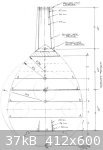
|
|
|
jdowning
Oud Junkie
    
Posts: 3485
Registered: 8-2-2006
Location: Ontario, Canada
Member Is Offline
Mood: No Mood
|
|
Physical constraints will dictate string length. Scaled at 54 cm string length gives a soundboard maximum width of 33 cm which seems about right - so
54 cm it is.
The oud profile and relative length/width of neck looked similar to the well known painting of a 5 course lute by Lorenzo Costa (1459 - 1535) so, for
interest, the layout sketch was rotated in perspective view for comparison. I didn't spent much time on this so didn't get perfectly matching
perspective angles (and the perspective of the painting is not quite correct) but it can be seen that the oud and the lute compare quite closely if
the 54 cm string spacing at the nut applies and the length of bridge is shortened in proportion.
The painting is quite interesting as it shows the right hand position that resulted during the transition from plectrum (risha) style to the new
finger style of the late 15th C. Here the first finger and thumb take the place of the plectrum - the thumb striking downwards and the first finger
upwards. Also note the thumb of the left hand projecting along the side of the fingerboard.
The four wooden frets on the soundboard are unusual.
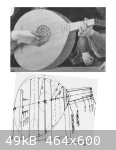
|
|
|
jdowning
Oud Junkie
    
Posts: 3485
Registered: 8-2-2006
Location: Ontario, Canada
Member Is Offline
Mood: No Mood
|
|
The attached image shows a drawing, to scale, of the oud with a string length of 54 cm. The width of fingerboard at the nut is 40 mm which will allow
for a slightly wider string spacing than 32 mm (if required) due to the relatively thicker bass strings of silk or gut. The neck joint is at the
revised H position so that the fingerboard length is 1/3 of the string length. The neck has a semicircular section with maximum depth at the neck
joint of 27 mm. The neck joint is vertical. The bridge has been shortened to maintain the proportions shown in the original engraving.
The bowl is semicircular in section, 16.5 cm maximum depth, and will have 11 ribs with no fillet strips between the ribs.
A decision has to be made about the number of soundholes - either two, as shown on the engraving, or three - including the 'imaginary' sound hole
assumed in the layout drawing. Either arrangement will likely work. Has anyone ever come across a picture of an early oud with only two sound
holes?

|
|
|
SamirCanada
Moderator
     
Posts: 3404
Registered: 6-4-2004
Member Is Offline
|
|
great stuff john!
|
|
|
jdowning
Oud Junkie
    
Posts: 3485
Registered: 8-2-2006
Location: Ontario, Canada
Member Is Offline
Mood: No Mood
|
|
Thanks Samir.
To 'complete the picture' and for general interest, the attached image is a drawing of an oud scaled exactly to the proportions of the engraving,
assuming a string spacing at the nut of 32 mm. The string length is 325 mm so it represents a little descant oud. Is there any evidence of small ouds
of this size ever being made?
Such an oud would still be a practical proposition as it comes close in size to the tiny mandolino lutes popular during the 17th/18th C.
It would be fun to build an oud of this dimension - just to see how it turns out so will plan also to make one to this drawing. If nothing else, it
will be a conversation piece.
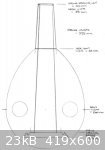
|
|
|
DaveH
Oud Junkie
    
Posts: 526
Registered: 12-23-2005
Location: Birmingham, UK
Member Is Offline
Mood: No Mood
|
|
This is really interesting stuff John.
I was just wondering though - 54cm does sound quite short for the string length. I understand you're keeping it that way both to avoid too much
stretching on the left hand and so that you can actually hold it, but a 30cm body width isn't that huge either. Many of the old oud illustrations show
very large-bodied instruments (though I guess they came in all sizes). I was just worried that 54cm might be too short. My renaissance lute was made
for a player called Paula Chateauneuf who is very petite indeed. It's 56cm. I like it even though I'm 6'2" and have long fingers, but I wonder if the
sound would suffer from too short a string length.
Related to that last point, do you have an idea yet what pitch do you plan to use? That must really be guesswork. As you know, the european sources (I
think it was Thomas Mace) tell you to tension the top string until it's just about to break (a tip which doesn't seem very useful to me as the easiest
way of telling this point is in retrospect!) but I'm betting you have something a little more scientific up your sleeve.
|
|
|
patheslip
Oud Junkie
    
Posts: 160
Registered: 5-24-2008
Location: Welsh Marches
Member Is Offline
Mood: smooth
|
|
Just done a quick sum. A string on my 60.5cm lute playing A (440) would play very close to B for the same tension and 54cm length. Assuming it's the
same for the other strings, (and I haven't made a fool of myself) that makes an instrument a whole tone above the normal Arabic oud. Could be good.
Putting a capo on my instrument I find it works as well as ever. 
Great project
|
|
|
patheslip
Oud Junkie
    
Posts: 160
Registered: 5-24-2008
Location: Welsh Marches
Member Is Offline
Mood: smooth
|
|
More simple sums: a 54cm lute/oud using the same strings would tune a whole tone higher than a 60cm instrument with tensions no more than one percent
different for any string.
string length
60cm 54cm
frequency nearest note difference
C 523.3 581.4 d 587.3 1.01%
G 392.0 435.6 a 440.0 1.01%
D 293.7 326.3 e 329.6 1.01%
A 220.0 244.4 b 246.9 1.01%
E 164.8 183.1 f# 185.0 1.02%
B 123.5 137.2 c# 138.6 1.01%
A 45cm string length would be fun to try, given infinite time and skill. The highest string would be f, then c, g, d etc .., like a sopranino
recorder to a descant.
40cm would give g,d,a,e...
We'll all be playing mandolins. ) )
(table won't align, sorry)
|
|
|
jdowning
Oud Junkie
    
Posts: 3485
Registered: 8-2-2006
Location: Ontario, Canada
Member Is Offline
Mood: No Mood
|
|
Thanks DaveH and patheslip.
The bowl width of the proposed oud with a string length of
54 cm is 33 cm and maximum depth of 16.5 cm - given a semicircular bowl section. A string length of 54 cm should not be a problem.
Bear in mind that gut or silk strings will be used which puts a limit on the highest pitch the top string can be tuned to. For
54 cm the highest pitch is about g' at A440 (ref. E. Segerman, N.R.I.) if frequent string breakage is to be avoided. For a 57 cm string length the
maximum would be around f#. Modern plastic strings can be taken to a higher pitch than gut or silk.
One of my lutes, based on the well known lute by Hieber of the late 16th C, has a string length of 60 cm so, although strung with nylon, the top
string is tuned to the gut string limit of f at A440. A 54 cm string length on this lute is equivalent to the second fret position (g').
I do not have much data about modern ouds but an old Egyptian oud that I own has a bowl width of 33 cm and maximum depth of 18.2 cm with a body length
of 51 cm (string length is 62.2 cm). This deep bowl section is also found on Baroque lutes of the 18th C. with bowl depths up to 18.5 cm. Earlier
lutes typically had flattened bowl sections. For the very largest lutes, according to my records, bowl depths might be, for example, 18.5 cm for a
bowl width of 40 cm (string length of 93.3 cm) and 17 cm for a bowl width of 42 cm (string length 89 cm). By comparison, a small 16th descant lute by
Tieffenbrucker has a string length of 44 cm, bowl width 21 7 cm and depth 10 cm - so the flattened section is not only for the physical limitations of
the player but has some effect on sound projection etc. A 44 cm gut strung lute would be pitched at b'flat.
A lute made by Railich in 1644 has a bowl width of 35 cm and length 42 cm (similar to our proposed 54 cm oud) but the bowl depth is only 14 cm.
In 1975, I built a replica of the Arnault de Zwolle lute that was quite successful. I do not have the lute anymore but still have my working drawing.
The string length was 54.5 cm, body width 33 cm and depth 16.5 cm with body length of 42 cm i.e. pretty much identical to the proposed oud dimensions.
This lute had six courses with a neck width at the nut of 50 mm and at the neck joint 76 mm - which resulted in an unusually deep neck section but
still possible to play. Nevertheless, the neck section was later reduced to more reasonable proportions.
The oud dimensions for a string length of 57 cm would give a bowl width 36 cm and depth 18 cm and depth of neck at the neck joint of 30 mm - not
impossible but 54 cm will be more reasonably proportioned.
It is difficult for me to predict how the finished instrument will respond. There will be a certain pitch at which the instrument will resonate best
so that factor also will dictate how high the strings will be tuned. International pitch standards will not be a consideration.
|
|
|
jdowning
Oud Junkie
    
Posts: 3485
Registered: 8-2-2006
Location: Ontario, Canada
Member Is Offline
Mood: No Mood
|
|
Also ...if I recall correctly, there was a recent posting on the forum where a member had a question about an oud with a 54 cm string length but I
cannot now locate the thread.
I understand that modern Turkish ouds can have a string length of about 57 cm?
The early iconography is probably too unreliable from which to judge the relative sizes of ouds. the instruments and players often being drawn out of
proportion to each other.
Recreating early instruments is always problematical!
|
|
|
jdowning
Oud Junkie
    
Posts: 3485
Registered: 8-2-2006
Location: Ontario, Canada
Member Is Offline
Mood: No Mood
|
|
A bit more information for interest. The little oud with 32 cm string length, gut strung, would have a top string maximum pitch of around e'' at A440
although this might be increased to g'' by choosing a lower pitch standard of , say, A375. Likewise, with a 54 cm string length in gut, the pitch of
the top string might be increased from about g' at A440 to about a' at A375 (this would also approximately apply to a 56/57 cm string length). Again,
the pitch standard chosen will depend upon how the instrument best responds.
According to Segerman (N.R.I.), the life of a gut top string (on a lute played finger style) might be anywhere from a few days to several months -
modern gut, being a natural product, varying considerably in strength from one string to another.
Silk being more uniform than gut, the strings might be expected to be more consistent in strength than gut. I have experience with using all silk
strings on a seven course lute and so know that they work well.
I do not know, at present, how use of a risha might affect the life of either gut or silk strings.
|
|
|
jdowning
Oud Junkie
    
Posts: 3485
Registered: 8-2-2006
Location: Ontario, Canada
Member Is Offline
Mood: No Mood
|
|
Still contemplating string lengths prior to making the mold.
Some time ago, Peyman posted a link to an interesting article concerned with the dimensions of Turkish ouds, tanburs and lavtas at
http://www.muzikbilim.com/3m_2004/ozek_e.html
The article is written in Turkish and on-line machine translation, as usual, does not help in understanding the text. However, the diagrams showing
relative proportions and dimensions are pretty well self explanatory. As far as the Turkish oud is concerned, four sizes are represented. Here I had
to resort to an on-line Turkish-English dictionary and have assumed that for the four headings "Zenne Kiz Ud" means a 'girl's oud' ; "Zenne Kadin Ud"
means a 'woman's oud'; "Kukuk Boy Erkek Ud" means 'small man's oud' and "Buyuk Boy Erkek Ud" means a 'large man's oud' (although 'Boy' could also mean
'boy'). However, as I have no knowledge of the Turkish language I could well be incorrect in this 'translation'. If one of the forum's Turkish members
could post a translation summarising the main points of the article, that would be very helpful.
What is interesting is that many of the relative dimensions of the Turkish oud correlate quite well with those of the revised dimensions of the oud
scaled from the engraving - although the body profiles and the relative bridge positions differ somewhat.
With the neck length being a third of the string length, both types of oud are the same. The overall body lengths vary by about 2 cm for each size and
width by about 1 cm (the Turkish ouds being slightly larger).
String lengths given for the Turkish ouds are : girl = 54 cm: woman = 55.5 cm; small man = 57 cm and large man = 58.5 cm. The largest of the Turkish
ouds has a body length of 48.75 cm, width of 36.56 cm and depth 18.28 cm (i.e. semicircular bowl section). For comparison the revised oud geometry for
the same string length of 58.5 cm scales to a body length 46.4 cm, width of 35.5 cm and depth 17.8 cm.
Given this data, I am now considering moving to a string length of 56 cm - as previously suggested by DaveH - rather than 54 cm. Both will give a
nominal maximum pitch of the top string of about g' at A440. The maximum neck depth in this case would be about 30 mm which should still be
acceptable.
|
|
|
jdowning
Oud Junkie
    
Posts: 3485
Registered: 8-2-2006
Location: Ontario, Canada
Member Is Offline
Mood: No Mood
|
|
So far the relative dimensions of the oud have been scaled up from the engraving overlay so there may be some geometrical errors. The oud has,
therefore, been drawn to full scale for a string length of 56 cm. A revised sketch of the geometry is attached for reference.
It is clear from this work that the previously proposed location of the neck joint B given by an arc R5 (as on the Arnault de Zwolle lute) does not
quite agree with a geometry of the fingerboard length being a third of the string length. By further examination of the full scale layout, two more
geometric relationships have been discovered.
The first is that if the distance from the centre line of the small soundholes to the centre of the brace above (i.e. distance FG - which is the same
as GH) is a value 'X' then the distance from the bottom of the bowl L to the first brace (shown dotted) is 'X' and the distance to the front edge of
the bridge JL is twice 'X'.
The bridge front edge dimension JL is also a sixth of the length of the bowl BL - which corresponds with the Arnault lute geometry.
Secondly, measuring from the inside of the bottom of the bowl, the distance to the centreline of the 'imaginary' large sound hole EK is 7 times 'X',
KX is 9 times 'X', the distance to the inside edge of the neck block KC is 11 times 'X' (which coincides with position C given by arc R3) and the
distance to the revised neck joint position KB is
12 times 'X'.
The locations of bridge, sound hole centres, braces and neck block remain in close agreement with the Mersenne lute proportions - to within a couple
of millimeters throughout.
The slightly higher neck joint position results in a reduction in the width of the neck joint to a more acceptable 53 mm - the depth of the neck then
being 26.5 mm for a semicircular neck section.
After making all of the necessary small adjustments to the full scale drawing, the overall string length now comes to 56.5 cm which is close enough to
what is required.
Work can now commence on making the mold - but not for the next few days as temperatures will be dropping to minus 36 C overnight - too cold to
operate the bandsaw in my main workshop.
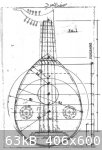
|
|
|
jdowning
Oud Junkie
    
Posts: 3485
Registered: 8-2-2006
Location: Ontario, Canada
Member Is Offline
Mood: No Mood
|
|
Temperatures warmed up today (currently minus 1 C) following a major snowstorm so took the opportunity to dig my way into my main workshop and use the
bandsaw to cut the base for the mold.
The mold profile was laid out - including centrelines and bulkhead positions - on a piece of 15 mm thick plywood from my scrap box. The profile was
made 2mm undersize all round to allow for rib thickness. String length is to be a nominal 56 cm.
Cheaper grades of plywood may contain voids as seen here - exposed when the profile was cut. No problem - the void has been filled with a scrap piece
of wood and will be trimmed to size after the glue has set.
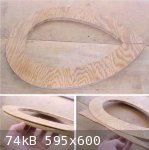
|
|
|
jdowning
Oud Junkie
    
Posts: 3485
Registered: 8-2-2006
Location: Ontario, Canada
Member Is Offline
Mood: No Mood
|
|
To facilitate accurate layout of the mold bulkheads, a pattern has been made on a piece of thin sheet metal (standard tinsmith pattern making
practice). The 11 rib positions (defined as radial lines) have been determined by trial and error using dividers. The outside ribs have been made a
few mm wider than the remainder.
The radial reference points have been pierced through the pattern with the point of a scriber. In use, the pattern is placed on the bulkhead blank and
the reference points transferred to the blank - through the holes in the pattern - using the point of the scriber. After removal of the pattern, the
transferred reference points, marked in the surface of the blanks, are then connected using a straightedge and marking knife.

|
|
|
jdowning
Oud Junkie
    
Posts: 3485
Registered: 8-2-2006
Location: Ontario, Canada
Member Is Offline
Mood: No Mood
|
|
The design of the mold will be the same as that given by Henri Arnault de Zwolle in the mid 15th C that is with 5 bulkheads except that an additional
bulkhead is to be added at approximately the centre of the sound hole position - for a little more support of the ribs in that location. This is not
essential - the most important area of support being at the bottom of the bowl where the rib curvature is greatest. For this reason Arnault de Zwolle
spaces the bulkheads in this area closer together.
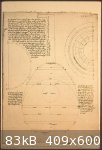
|
|
|
jdowning
Oud Junkie
    
Posts: 3485
Registered: 8-2-2006
Location: Ontario, Canada
Member Is Offline
Mood: No Mood
|
|
The central bulkhead of the mold has been laid out on a piece of 15 mm thick pine (pine is easier to work with than plywood) using the metal template
and trammels (beam compass) to scribe the circumference. For an 11 ribbed bowl, the maximum rib width will be about 50 mm (2 inches) with the outside
ribs being a bit wider at around 55 mm. With these relatively wide ribs that will be less than 2 mm thick (dependent upon the specific gravity of
bowl material chosen), the outside profile of each bulkhead will be flattened at the rib positions (according to Arnault de Zwolle's instructions) -
the bowl being constructed like an early lute rather than having the smooth rounded profile of a modern oud. (The early Arabic writers indicate that
the ribs of an oud should be made thinner than the sound board).
It is also likely that ribs of this width and thickness will become slightly fluted after bending but no compensation for that is currently to be made
in mold design unless the fluting turns out to be more significant than anticipated.
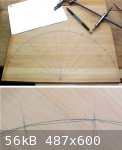
|
|
|
| Pages:
1
2
3
..
16 |